The Great Canadian Flag Debate
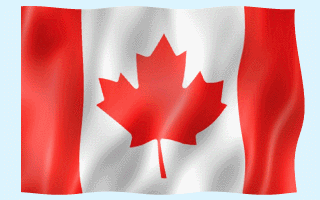
This past Friday was National Flag Day in Canada. This year marked 54 years since Her Majesty Queen Elizabeth the Second, Queen of Canada, proclaimed our flag into law on January 28,1965. At noon on February 15, 1965 the Red Ensign flying on our Parliament buildings was lowered and replaced with the new maple leaf design which is now known throughout the world as representing Canada.
Wait, What? Canada Didn’t Have a Flag Until 1965?
That’s right, let’s explore that subject.
Unlike our neighbours to the south, who established their independence and sovereignty forcefully, Canada’s evolution as a sovereign nation has been carried out over time. Our American neighbours established their own form of government, their own national symbols, flag and their own constitution very early on.
In Canada, those elements have been a process which started with Confederation in 1867 when the four original provinces came together to form the Dominion of Canada. We retained the Westminster Parliamentary process with a Constitutional Monarch as head of state. The French represented by the Province of Quebec and a founding language would have status along with the then dominant English. That had been established after the Plains of Abraham and was carried into the Confederation.
The Roots of Our Great National Debates
Those early decisions for French and English to cohabitate within Canada has led to what is often referred to as the two solitudes. At times the unity between the two groups creates an uneasy tension within the country and has influenced every step Canada has taken as it evolved into the country it is today.
The English, usually of British descent in the early days, saw the use and adaption of British symbols as a nod to our British heritage and roots. The French chaffed at the use of anything British, dismissing them as being symbols of colonialism. The longstanding rivalry between England and France brought to the New World and made raw by the defeat of the French forces on the Plains of Abraham.
In order to evolve and establish our presence as a united sovereign country, it was necessary for the English part of the country to hear without dismissing the concerns of the French part of the country. It was not an easy process and die hards within each group would often dig their heels in at every step of the way. The ensuing debates forced the country to find paths which would honour both parts of our shared history.
The Path to a National Flag
The path to our national flag was long, stretching back to the very beginning of the country. There was a desire to have a distinctive Canadian flag, how to get to that point was a point of contention. Those of British roots wanted familiar symbolism as part of the flag, the French wanted any links to British roots eliminated but would have been okay with retaining links to French roots.
Canadian Red Ensign
The Canadian Red Ensign, a red flag with a Union Jack, referred to as the Union Flag in Canada, in the top left corner and a coat-of-arms on the right served as an unofficial flag until 1965.
 |
 |
 |
|
|
1921-1957 |
|
Their first use started at Confederation in 1867 prompting Lord Stanley (of the Stanley Cup fame) to write to London:
“The Dominion Government has encouraged by precept and example the use on all public buildings through the provinces of the Red Ensign with the Canadian badges on the fly … [which] has come to be considered as the recognized flag of the Dominion, both ashore and afloat”
Even the Ensign wasn’t consistently the same. At confederation the coat-of-arms on the Ensign depicted the four original provinces. As other provinces joined the confederation, the coat-of-arms changed to include them.
In 1921 after Canada adopted its official coat of arms the British admiralty approved the use of the Red Ensign with the coat of arms of Canada for use at sea. In 1924 an Order in Council (similar to an American Executive Order) approved the use of the coat of arms on the Red Ensign which was in use on Canadian government buildings abroad.
Canadian Coat of Arms
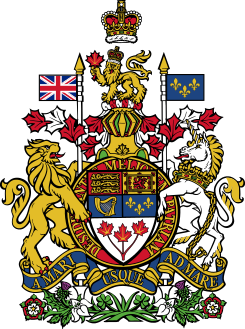
While establishing the coat of arms of Canada the maple leaf and the colours of red and white were incorporated as officially Canadian.
The red came from the British Saint George’s Cross and white from the French royal emblem in use since King Charles VII.
The maple leaf had been first used as a national emblem in 1868 when it appeared on the coat of arms for both Ontario and Quebec.
In 1860 the Royal Canadian Regiment adopted the maple leaf as their regimental symbol. During both WW1 and WW2 the badges of the Canadian Forces were based on maple leaf designs.
The maple leaf also appeared on all Canadian coins from 1867 until 1901. It remained on the penny from 1901 until Canada discontinued the coin in 2013
Failed Flag Committees
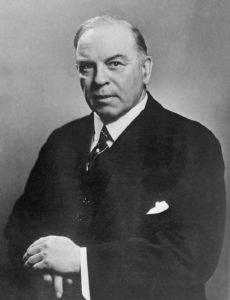
Prime Minister Mackenzie King
A 1925 committee established by Prime Minister William Lyon Mackenzie King to design a flag for use at home dissolved before it could deliver a final report. Public sentiment still wanted the flag problem fixed. New designs continued to be brought forward without action.
At the outset of WW2, the Red Ensign was recognized as Canada’s national flag. A joint committee of the House and Senate convened in 1945 received over 2000 designs from the public. This committee did manage to report to parliament with a recommended flag: the Canadian Red Ensign which replaced the coat of arms of Canada with a maple leaf in autumn gold colour with white border.
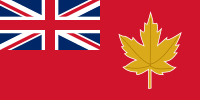
The Legislative Assembly of Quebec recommended the committee not use any ‘foreign symbols’ which included the Union Flag. Canada was already dealing with a conscription crisis driven largely by anti-British sentiment in Quebec. Prime Minister Mackenzie declined to act and left the order for the Canadian Red Ensign in place.
In 1957 another order in council replaced the three green maple leaves on the coat of arms with three red maple leaves.
The Great Canadian Flag Debate
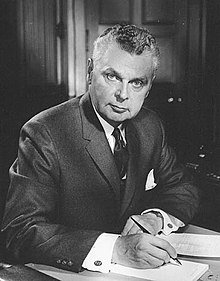 Prime MInister Diefenbaker |
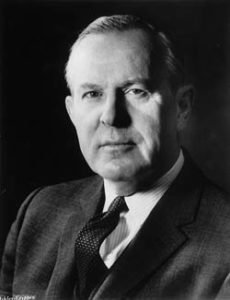 Prime Minister Pearson |
By 1958 extensive polling across the country indicated 80% of Canadians wanted a national flag entirely different from any other nation and 60% wanted the flag to bear a maple leaf.
It would be Prime Minister Lester B Pearson who would shepherd in our national flag but not before a divisive national debate took place and a motion of closure to force the end of debate in parliament was used.
Pearson was a WW1 veteran and lived a life of public service. He was head of Canada’s delegation to the UN from 1948 to 1956. He represented Canada at the founding of NATO in 1949. In 1957 he received the Nobel Peace Prize for his efforts in solving the Suez crisis and bringing the concept of peacekeeping forward.
It was during that crisis that Pearson encountered a solid reason why Canada needed its own distinctive national flag. The Egyptian government objected to having Canadian peacekeepers on the ground. The reason? The Red Ensign contained the Union flag aka the Union Jack, one of the belligerents in the crisis and the Egyptians couldn’t separate Canada from Britain.
As the leader of the Official Opposition in 1960, Pearson issued a press release on January 27, 1960 which stated:
“Canadian Government taking full responsibility as soon as possible for finding a solution to the flag problem, by submitting to Parliament a measure which if accepted by the representatives of the people in Parliament, I hope, settle the problem.”
Pearson wanted a distinctive Canadian flag that would not be mistake for any other. Prime Minister John Diefenbaker, fiercely pro-imperial wanted no part of removing imperial symbols. Pearson responded by making a new national flag part of the election campaign. The 1963 election saw the Liberals with a minority government and a promise to keep of a new flag in two years.
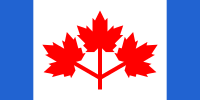
Pearson Pennant
His preferred choice was a flag with two blue side bands and three red maple leaves in the center on a white background. This became known as Pearson’s Pennant although many veterans would go on to call our national flag ‘Pearson’s Banner”. Veterans organizations like the Royal Canadian Legion and the Canadian Corp were opposed to removing symbolism of our ties to the United Kingdom and the Commonwealth of Nations.
On June 15, 1964 Pearson opened the flag debate with the following resolution:
“… to establish officially as the flag of Canada a flag embodying the emblem proclaimed by His Majesty King George V on November 21, 1921 — three maple leaves conjoined on one stem — in the colours red and white then designated for Canada, the red leaves occupying a field of white between vertical sections of blue on the edges of the flag.”
The Conservatives led by Diefenbaker responded with fierce opposition using every parliamentary trick they could muster in a minority government. Parliament continued to debate throughout the summer and by September Pearson yielded to a suggestion to create a special flag committee, giving them six weeks to complete their work.
The Conservatives were counting on the committee netting the same lack of results as previous committees. Over the next six weeks, 3,541 entries for flags arrived, 2,136 contained maple leaves, 408 Union Jacks, 389 beavers and 359 Fleurs-de-lys.
 Royal Military College Flag |
 Original Version |
At the last minute, Liberal committee member John Matheson from Ontario slipped in a design from George Stanley whose idea had come to him at the Royal Military College and was based on the college’s flag. In a memorandum to Matheson in March 1964, on the history of Canada’s emblems Stanley had warned, any new flag "must avoid the use of national or racial symbols that are of a divisive nature" and that it would be "clearly inadvisable" to create a flag that carried either a Union Jack or a Fleur-de-lis. The design put forward had a single red maple leaf on a white plain background, flanked by two red borders.
The final choices came down to Pearson’s Pennant and Stanley’s design. The Conservatives backed Stanley’s choice assuming the Liberals would back the Pearson Pennant. The Liberals voted for Stanley’s choice making the final decision 15-0.
The committee’s recommendation was brought to Parliament and notwithstanding the support the Conservatives had given the flag at committee, Diefenbaker continued to vehemently oppose the flag. Debate dragged on until the Pearson government invoked closure forcing a vote which took place at 2:15am on December 15, 1964. With other Opposition parties and francophone Conservatives backing the government, the motion passed 163 to 78.
That afternoon, the Commons voted in favour of continuing to use the Union Flag as a symbol of Canada’s allegiance to the Crown and our membership in the Commonwealth of Nations. The Senate approved two days later and the Royal Union Flag would fly alongside the new flag on days of Commonwealth significance.
The Fate of The Canadian Red Ensign
While largely removed from public awareness in the intervening 54 years it can still be seen at times. Veterans organizations like the Royal Canadian Legion include it in their official colour parties placing it third in line after the National flag and the Royal Union flag. It represents and remembers those who fought and died under it in two world wars, Korea and other operations prior to 1965.
In recent years, white supremacist groups have co-opted the Ensign much like the Confederate flag has been used in the United States. There is no small amount of irony that a flag under which so many fought and died for freedom for all, is being used in this manner.
"[it] will symbolize to each of us—and to the world—the unity of purpose and high resolve to which destiny beckons us" — Governor General Major-General Georges Vanier, Feb. 15, 1965
NOTE: images from Wikipedia
Posted from my blog with SteemPress : http://idesofmay.com/2019/02/17/the-great-canadian-flag-debate/
Hi @shadowspub!
Your post was upvoted by @steem-ua, new Steem dApp, using UserAuthority for algorithmic post curation!
Your UA account score is currently 6.095 which ranks you at #283 across all Steem accounts.
Your rank has not changed in the last three days.
In our last Algorithmic Curation Round, consisting of 244 contributions, your post is ranked at #3. Congratulations!
Evaluation of your UA score:
Feel free to join our @steem-ua Discord server
Ah, the flag, and ensign.
Well written, and a great look back at history, of the Ensign and eventually the Flag of Canada.
thank you ... I learned a few things I never knew like about Pearson's experience with the Egyptians. Hat off to him for being so determined to bring us a distinctive national flag.
I'm pretty happy with our new flag, the beaver would have been interesting though. Great read.
Posted using Partiko Android
Yes I like it as well. Oh in this day and age.. how the beaver would end up played with ... oh my
Interesting. I like the one with 3 leaves and blue bands.
Posted using Partiko Android
It's nice but I do have to admit that the red and white seems to draw my eye more. That is coming from someone who's favourite colour is blue. I suspect the argument would have arose that the red white and blue draws on either the Americans or the Brits ... choose your argument of the week.
There are some who claim that our flag is red and white because red is the Liberal's colour, the detail that red and white was declared our national colours by the Crown when approving our coat of arms is lost to history.
I suppose we could also say that red is closer to a brown and Maple Syrup is a reddish brown and Canada is the land of Maple Syrup. Sounds like a...SWEETER explanation :p
Hi, @shadowspub!
You just got a 0.29% upvote from SteemPlus!
To get higher upvotes, earn more SteemPlus Points (SPP). On your Steemit wallet, check your SPP balance and click on "How to earn SPP?" to find out all the ways to earn.
If you're not using SteemPlus yet, please check our last posts in here to see the many ways in which SteemPlus can improve your Steem experience on Steemit and Busy.
Congratulations @shadowspub! You have completed the following achievement on the Steem blockchain and have been rewarded with new badge(s) :
Click here to view your Board
If you no longer want to receive notifications, reply to this comment with the word
STOPTo support your work, I also upvoted your post!
Do not miss the last post from @steemitboard:
Well my goodness that was like a history lesson! hehehe
so many flags - but that coat of arms is my FAVORITE!!!! i absolutely LOVE coats of arms! that might be a fun Monkee contest to do - have them all design their own coat of arms for their family hehehe
Congratulations! This post has been chosen as one of the daily Whistle Stops for The STEEM Engine!
You can see your post's place along the track here: The Daily Whistle Stops, Issue 406 (02/20/19)
It is amazing how there are so many similarities in the way humans in "the new worlds" evolved to where we are now.
Even down to having certain flags used by those who do not represent anything that the flag symbolizes.
In Australia, we actually had a rebellion against the "establishment".
Yes, I used the right term there, it was a rebellion against "the establishment".
Some people with agendas twist that around to suit their twisted ideas of what they want Australia to be. Luckily, all the few extremists who undermine the historical value and huge contribution that this rebellion had in Australia becoming one nation with freedom, democracy and "Aussie mateship" as a foundation, are just that, small groups of extremists (on both sides of the fence).
ref: https://en.wikipedia.org/wiki/Eureka_Flag
I guess the USA kinda got the Brits "worried" and then add to that The rebellion in Victoria (Australia) it was inevitable that they concede to our peoples who united and made it clear that we are no longer "Brits" but a new nation made up of many and yet united by common values, dreams and the strongest of bonds among humans in hard times.
Loved the post.
God bless Australia, God bless Canada and God Bless The USA and God Bless all the peoples of this world who strive to achieve what we have achieved in our great nations.
Cheers.
Speaking of Rebellion in Australia, I had a Pinot Noir, from Downunder, called 19 crimes.
no idea what that has to do with anything other than, hey, it was cheap, like our friends, and a good couple bottles for dinner at our neighbors, last night.
The Aussies and the Kiwis come up with some creative names for their wines. First introduced to that when I read a review of one called Cat's Pee on a Mulberry bush. It was a very good wine and didn't taste at all like Cat's Pee... well what I think it would taste like. Another was the Cat's Paw.
When someone recommended Fat Bastard to me as a wine I might enjoy, I immediately thought it would be either Aussie or Kiwi.... was surprised to discover it is a French wine.
So many vineyards downunder that the owners are naming wines after all sorts of things, such as how many crimes they have committed, how many times they've done things in public places and so on.
I think Australia is one of the few places on this earth that can't produce enough booze for its own nation.
Remember reading something about that once upon a time, maybe that has changed with the times though, who knows.
with the amount we drink in the states?
Clearly the States do not produce enough to last!!!
ah so the Eureka Flag has its origins with a rabble rousing Torontian... Damn Canucks eh
Former Canuck! New Australian.
But yeah, let's just go with "An Aussie with a funny accent".
:)
you never know .. he may have returned to Canada as his compatriot did but for his untimely death.
Still doesn't change the fact that he was a part of the new nation being born there.
So he's an Aussie in my books.
ǝɹǝɥ sɐʍ ɹoʇɐɹnƆ pɐW ǝɥ┴